Close Calls From the Cosmos

A gigantic asteroid is threatening to collide with Earth as a crack team of scientists from around the world scrambles to blow it out of the sky and save humanity before time runs out. This is the premise of numerous memorable meteor movies – but the plot is not so far-fetched as it may seem.
Small asteroids frequently whiz past Earth or enter our atmosphere and burn up. Even relatively small asteroids are capable of inflicting major damage should they penetrate our atmosphere and explode in a populated area. In 2013, a meteor about 17 meters wide caused a massive explosion and injuries – but thankfully, no deaths – in Chelyabinsk, Russia. One about twice that size leveled more than 2,000 square kilometers of trees in 1908. Fortunately, the area wasn’t populated. Massive casualties would likely have resulted if it had been.
Then there’s the big one. An extinction-level asteroid event that many scientists say ended the dinosaurs could, one day, end us.
We also wondered what kind of devastation might be caused to iconic American cities if these objects were to hit. To find out, we combed NASA’s database of past and future NEOs and then estimated the impact of a few of them. Here’s what we found.
Close Near-Earth Encounters
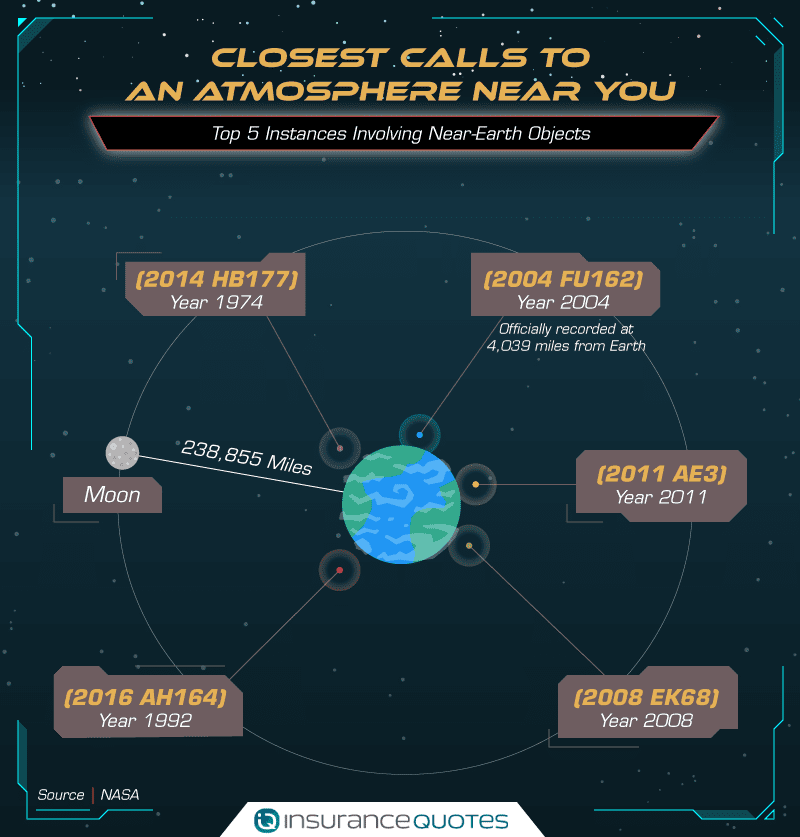
NEOs are comets or asteroids that orbit the sun and come close to – or even intersect with – the Earth’s orbit. They can be just a few feet in size (whew!) or several miles in diameter (yikes!). The asteroid suspected of killing the dinosaurs is thought to have been about 6 miles wide.
We analyzed NASA’s database of more than 36,000 recent close encounters to find the five closest near-earth objects. All of these NEOs are estimated to be quite small, between 5 and 8 meters in diameter. But don’t relax just yet. It’s estimated that more than 300,000 NEOs exist that are more than 40 meters wide and could potentially cause damage by crashing into Earth or exploding in the sky. (To provide some perspective, the NEO that flattened the Russian forest in 1908 is estimated to have been about 40 meters wide, exploding with the force of about 5 to 10 megatons of TNT.) If that news isn’t troubling enough, all of these 300,000 pesky NEOs have yet to be identified, according to the National Science and Technology Council.
In a New York Impact
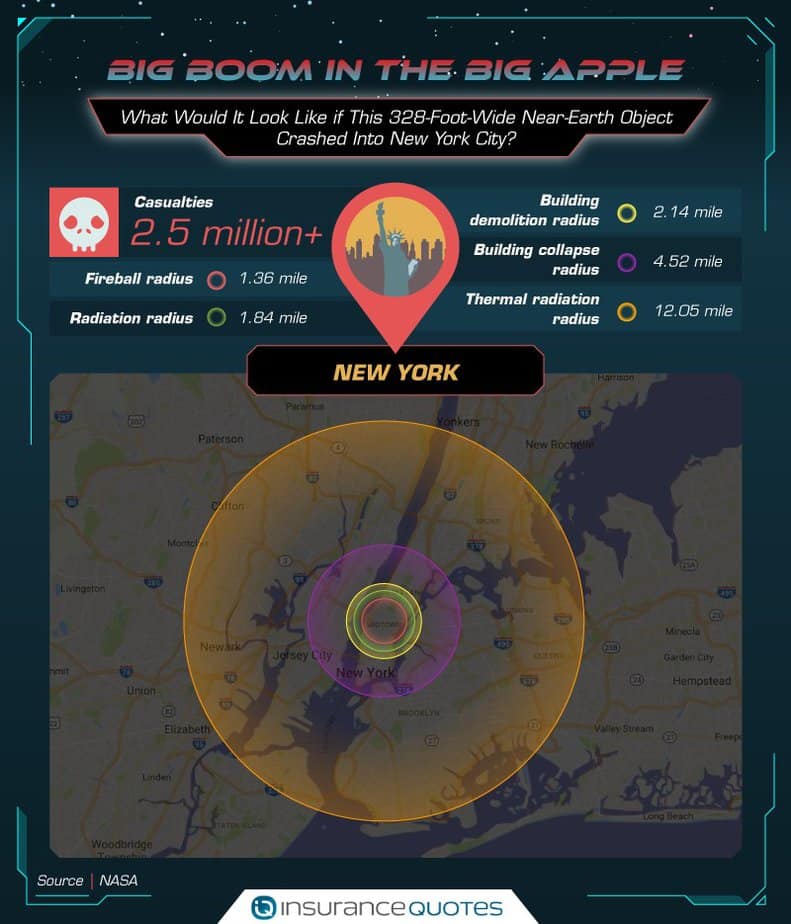
The film “Deep Impact” (1998) imagines – in vivid detail – what New York City might look like were it bombarded with comets from space. It isn’t pretty. Buildings and people are obliterated as fireballs zoom overhead and sea levels rise. Hollywood is full of exaggeration, but if an NEO like 2013FK were to crash into Earth, the scenario presented in the film may not be so far afield.
If the island of Manhattan were ground zero to a substantial NEO, the results would be devastating. According to our calculations, there would be more than 2.5 million deaths, and people as far away as Yonkers, Queens, and Newark would likely sustain skin burns.
San ‘Fried’cisco
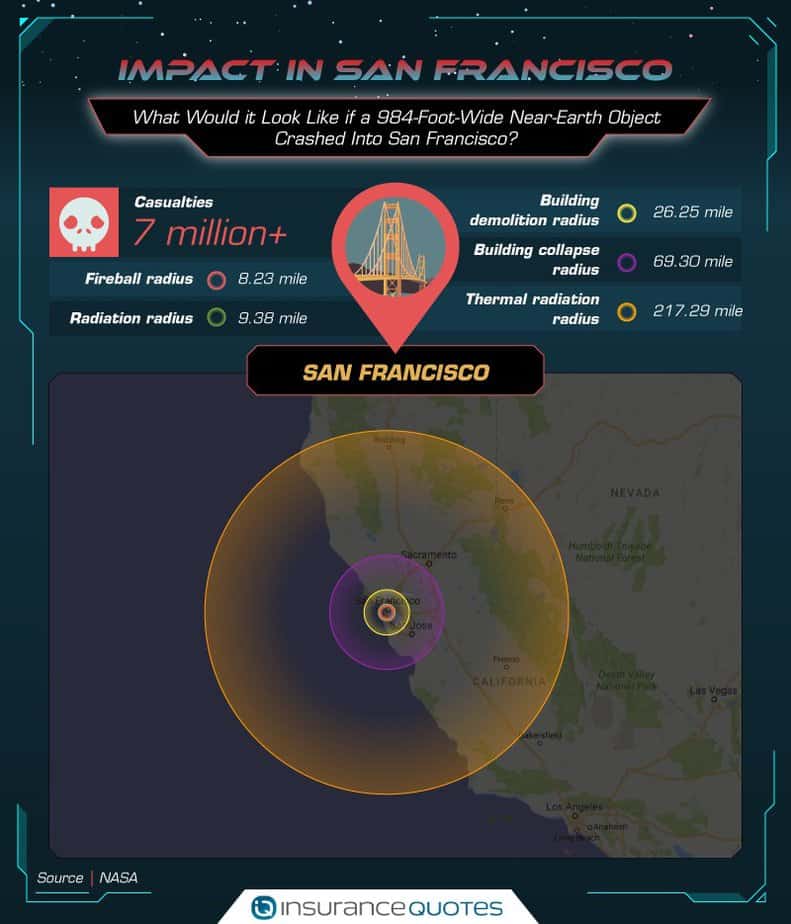
With California’s propensity for earthquakes, residents are somewhat accustomed to living under the threat of a natural disaster. San Francisco, in particular, has experienced a number of damaging and dangerous earthquakes. Since 1979, four earthquakes with a magnitude of 5 or greater on the Richter scale have struck the city. The good news is that if a near-Earth object were to strike the Golden City, its residents would probably be somewhat prepared for a sudden environmental event. The bad news is that the force of the NEO could trigger earthquakes in an area that is already unstable.
In our imagined scenario of 2015 BN509 hitting San Francisco, about half of the impact would, thankfully, occur over the Pacific Ocean. That in itself could cause powerful tsunamis to strike coastal areas all along the Pacific Ocean and beyond. The deadly impact in the continental United States would extend well to the west – easily affecting Reno and Lake Tahoe.
Windy City Wipeout
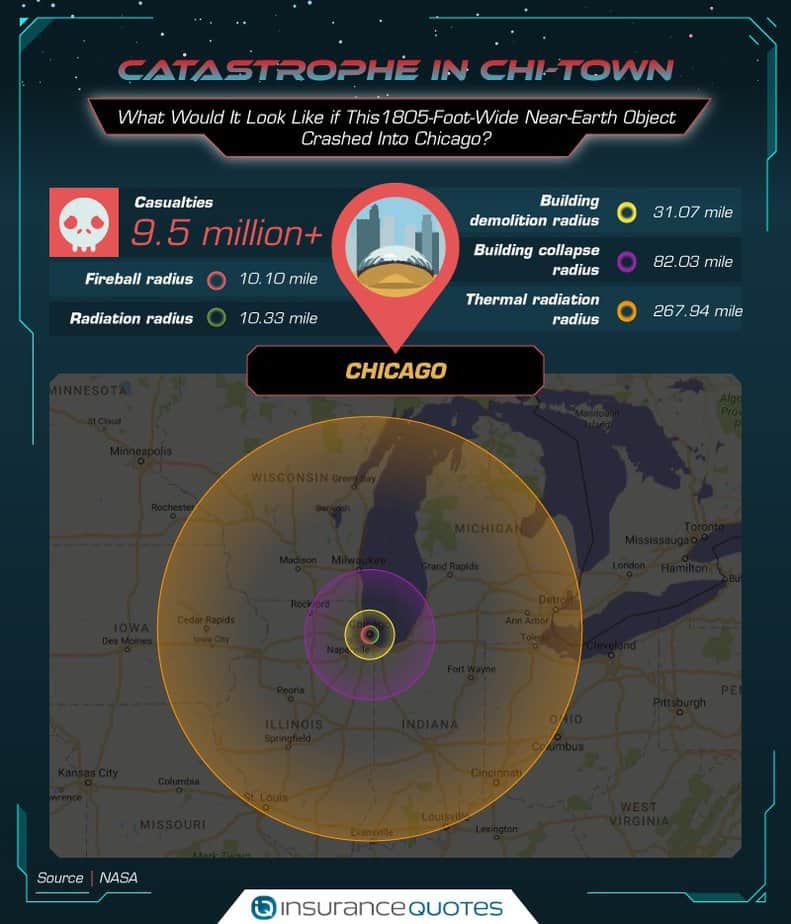
Our scenario of a major near-Earth object impact on Chicago is the deadliest of all. With a radius of searing heat extending beyond the Windy City to the populous cities of Grand Rapids, Cedar Rapids, Milwaukee, Indianapolis, Louisville and St. Louis – the death toll would well exceed 9 million. This illustrates that where an NEO strikes is significant in terms of its overall impact on human life.
Faster Than a Speeding Meteor

When we think of giant space rocks, we may imagine them as slow-moving behemoths, gradually lumbering through the solar system. In fact, these objects are whizzing through space at an alarming speed. This graphic illustrates just how quickly. Would Earth’s best scientists move quickly enough to stop “the big one” if it were discovered to be heading our way?
Unlike earthquakes, volcanoes and tsunamis (which can be impossible to detect before their disastrous forces strike), scientists can predict large NEOs years in advance. This means governments around the world could work together to blow one out of orbit. If this sounds like the far-fetched plot of a meteor movie, it is. It also happens to be the reality.
Looking Skyward for Salvation
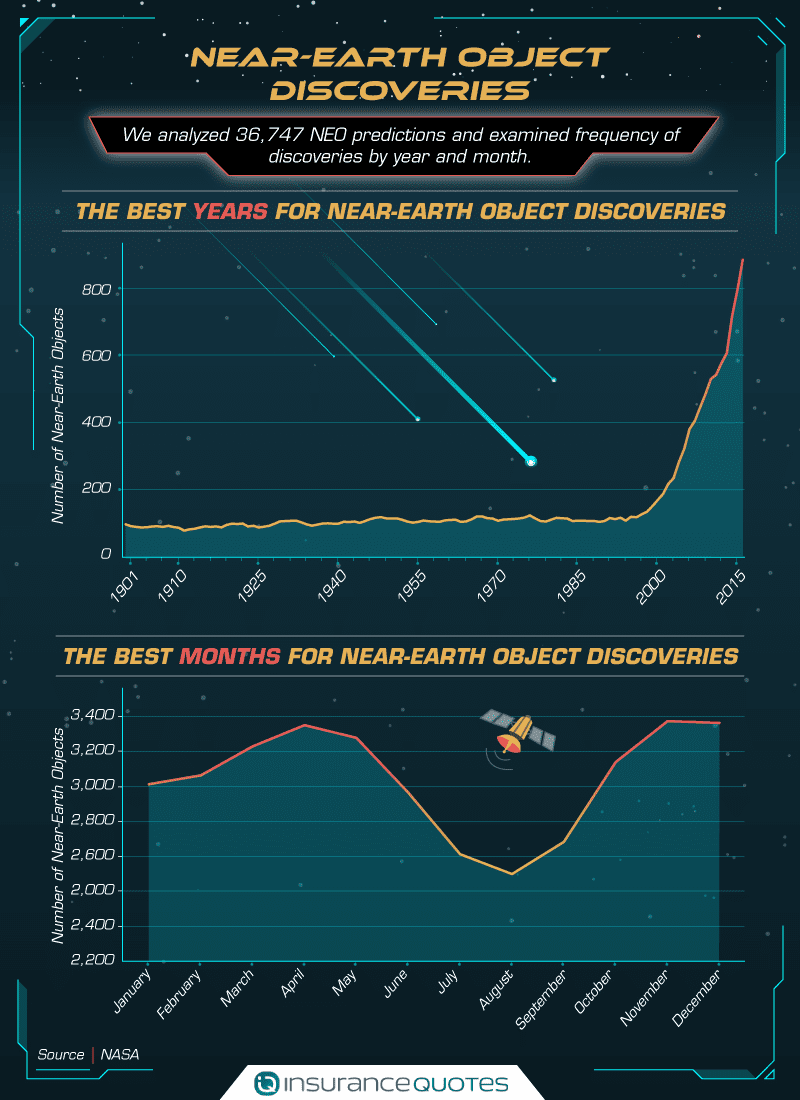
Recently, the U.S. government created a national NEO preparedness strategy that includes a mandate to find, track and categorize NEOs for the purpose of reducing their potential harm to Earth and its people. The United States works through its agencies, such as NASA, and outside organizations.
In 2004, the Catalina Sky Survey project discovered 84 asteroids near Earth, second to the LINEAR project’s 304. By 2005, Catalina exceeded LINEAR by 172 discoveries and discovered the most NEOs each year until 2014, when Pan-STARRS came onto the scene. Now the two programs discover more than 1,000 NEOs per year.
NEO Trends for the Future
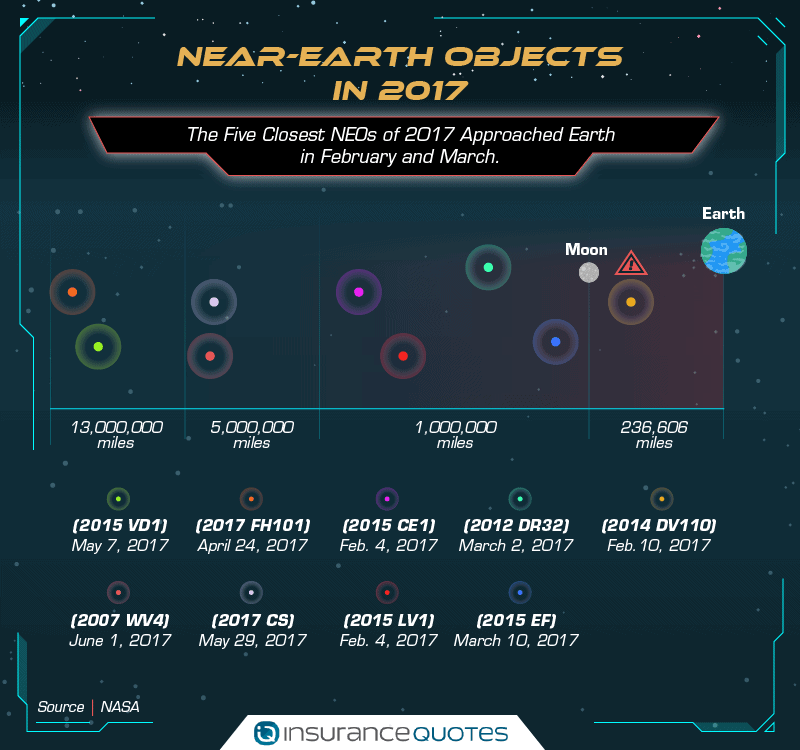
A lightning bolt in the form of an asteroid or comet can rain down from the sky with little or no notice. However, some NEOs have been identified – so we know they’re headed our way. Here are five that will approach Earth in February and March of 2017. The closest will come between the Earth and moon, and is an estimated 28 to 62 meters in diameter. In the past before automated searches, some months were better than others for personal detections of NEOs; in June and December, the Milky Way tends to get in the way of night visualization. In June, nights are short, and in December, they’re cold – which drove NEO hunters indoors.
Preparing for the Unexpected
The average person has little to worry about from falling space objects – everyday dangers here on the ground are a far more likely concern. Nobody expects to be affected by an accident or catastrophe, but millions around the world face this reality every year. We may not know if, when, or how it’ll happen, but we do know how to prepare for when it does. When the unexpected strikes, having the right insurance is crucial, and insuranceQuotes can help you find the best rates on the coverage you need. Visit us online today.
Methodology
We analyzed 36,747 NASA records of near-Earth objects to determine which were the largest and closest to approach. To predict what an NEO impact might look like in a given city, we found the impact energy of selected NEOs using an impact calculator, converting the impact energy (joules) into megatons of TNT. We then applied this TNT value to a tool called Nukemap to simulate what a given impact would look like. We sourced approximate values, such as the minimum velocity an object needs to impact Earth, the density of the projectile, NEO diameter, distance and velocity. To calculate death tolls, we matched population data to impact ranges with 100 percent fatality rates.
Sources
http://screenpicks.com/2013/02/meteors-in-the-screen/
http://www.businessinsider.com/asteroid-flyby-nearer-than-moon-2017-1
https://www.psi.edu/epo/ktimpact/ktimpact.html
http://www.imdb.com/title/tt0120647/?ref_=fn_al_tt_1
http://www.earthquakesafety.com/earthquake-history.html
Fair Use Statement
If you’ve gotten a blast out of this article, feel free to share the graphics or text on your site for noncommercial purposes. Please link back to this page and credit insuranceQuotes.
